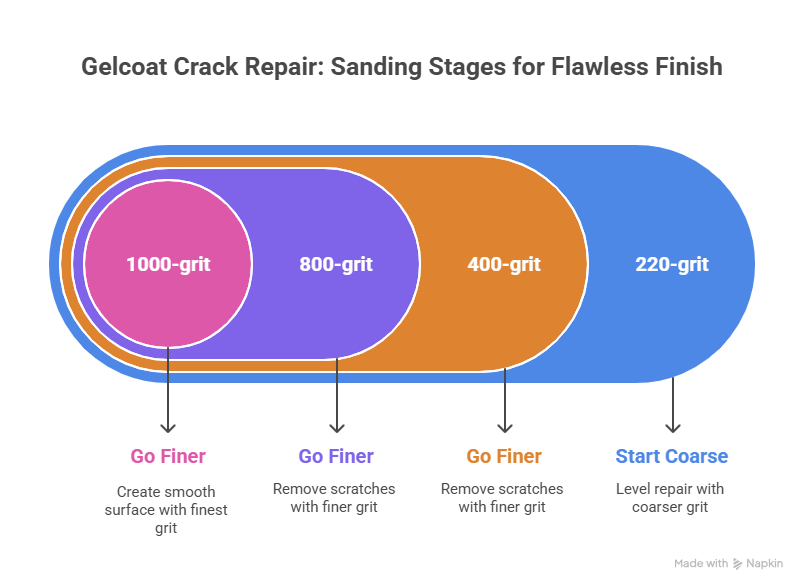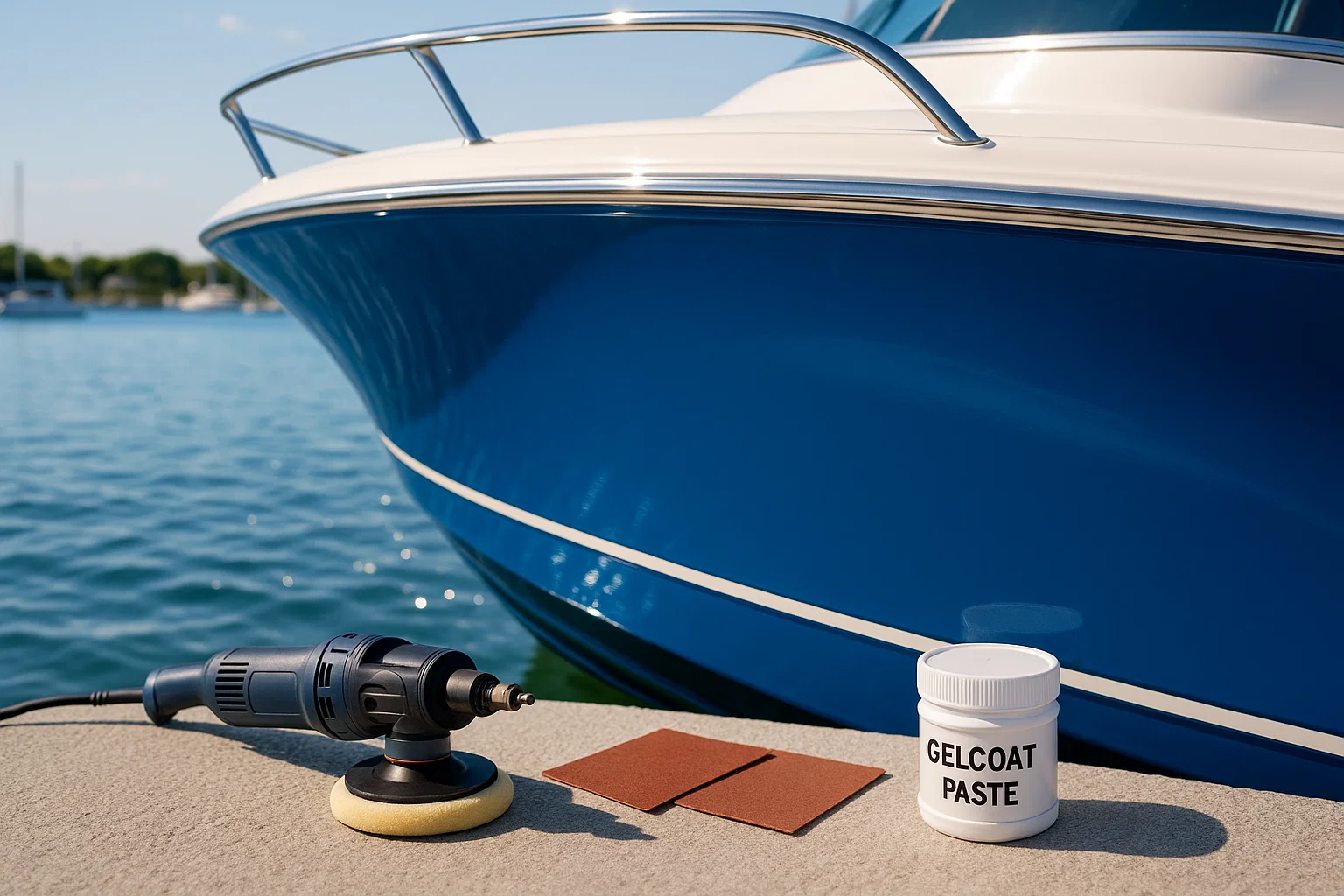Mastering Gelcoat Crack Repairs for Boaters: My Miami Marina Playbook
I’ve been fixing boats in South Florida for 15 years, starting with my uncle’s Sea Ray in a Fort Lauderdale garage back in 2010. Those spider cracks snaking across your hull? They’re a gut punch—ruining the shine and hinting at trouble. Last July, Maria at Coconut Grove Marina brought me her Yamaha SX210 with crazing from a dock bump; a $400 patch I did saved her from a $1,200 boatyard bill. Here’s my hands-on guide to nailing gelcoat repairs that look factory-fresh and last. It’s not rocket science—just prep, patience, and the right tricks.
How Do I Spot Gelcoat Cracks Like a Pro?
Gelcoat’s your boat’s glossy shield—a polyester resin layer protecting the fiberglass from Miami’s sun and saltwater. I learned its value in 2012 when a client’s Bayliner 265 got water damage from ignored cracks—cost him $2,000. Before you touch a tool, figure out what you’re dealing with.
What Causes Gelcoat Cracks on Boats?
Cracks tell a story. Last June, Ray at Key Biscayne showed me his Boston Whaler’s deck with spider cracks near a cleat—classic stress from loose hardware. Here’s what I see:
- Dock Bumps: A nudge or dropped wrench leaves gouges.
- Hull Flexing: Rough waves cause stress cracks, especially near fittings.
- Thermal Cycling: Miami’s 90°F days to 70°F nights fatigue gelcoat.
- Bad Application: Thick gelcoat from the factory turns brittle.
Tap the hull with a screwdriver handle. Sharp sound? Cosmetic fix. Hollow thud? That’s delamination—call a pro. I caught this on a Grady-White at Stiltsville last month, saving a $3,000 repair.
How Do I Prep a Crack for a Rock-Solid Fix?
Prep’s the game-changer—90% of a good repair. I botched a patch in 2011 by rushing; peeled in weeks. Here’s how I set up for a fix that sticks.
How Do I Clean and Assess the Damage?
Start with marine soap to strip salt and wax—lets you see the real issue. Last summer, a buddy’s Fountain 38 at Bahia Mar had what looked like crazing but was deeper stress cracks.
- Check Patterns: Spider cracks are cosmetic; linear or deep cracks near fittings suggest stress.
- Magnify: Use a magnifying glass for tiny cracks.
- Tap Test: Hollow sounds mean trouble—don’t patch.
I referred a client to a fiberglass specialist after a hollow tap in 2024; saved a $4,000 mess.
What Tools and Materials Do I Need?
I keep my kit ready to avoid mid-job runs to West Marine. Here’s my go-to:
- Tools: Dremel with #106 bit, plastic spreader, sandpaper (80, 220, 400, 800, 1000-grit wet/dry), sanding block, mixing cups.
- Materials: West System gelcoat paste, color pigments, acetone, plastic film or PVA spray, 3M rubbing compound, 3M Marine Wax.
- Safety Gear: Nitrile gloves, safety glasses, respirator—acetone’s no joke.
Skipped gloves once in 2013; spent days scrubbing resin off my hands. Don’t be me.
How Do I Grind the Perfect V-Groove?
The V-groove’s your secret weapon—gives the paste a solid grip. I fixed a Sea Ray’s gouge at Coconut Grove last July with this trick; client couldn’t spot the repair.
- Use a Dremel on low to carve a shallow V along the crack, staying in the gelcoat layer.
- Sand edges with 80-grit to feather them for blending.
- Wipe with acetone-soaked rags—non-negotiable for adhesion.
I skipped acetone in 2012; patch failed in a month. Take your time here.
How Do I Apply Gelcoat Paste for a Seamless Fix?
Picking the right paste is half the battle. I’ve patched 300+ hulls, and the wrong choice means a weak or visible repair.
Which Paste Works Best for Gelcoat Cracks?
West System gelcoat paste is my go-to for spider cracks—matches the hull and costs $40. For deeper stress cracks, I’d use epoxy like WEST SYSTEM 105 with 406 Colloidal Silica, topped with gelcoat for UV protection. Fixed a Yamaha’s stress crack this way in June 2024—saved $600.
How Do I Mix and Apply the Paste?
Mix small batches; Miami’s heat kicks off paste fast. I botched a mix in 2014 by guessing the catalyst—patch hardened too quick.
- Follow the manufacturer’s ratios exactly.
- Press paste into the V-groove with a spreader, overfilling slightly—it shrinks.
- Seal with plastic film or PVA spray to block air.
I did a quick patch on a Bayliner at Key Biscayne last spring—overnight cure, perfect bond.
How Do I Polish a Repair to Factory Shine?
Finishing’s where you make the repair vanish. I polished a Grady-White at Dinner Key in July 2024; owner swore it looked better than new.
How Do I Sand for a Smooth Blend?
Wet sanding’s key—keeps dust down, smooths better.
- 220-grit (dry): Level the raised paste.
- 400 to 1000-grit (wet): Blend edges, expanding slightly each grit.
- I sanded a Sea Ray’s crack this way last month—20 minutes to a haze-free base.
How Do I Match the Hull’s Color?
Faded hulls are tough. I sent a chip from a client’s 2010 Yamaha to Spectrum Color—$60 for a perfect match. Aim slightly lighter; repairs darken over time. Brush or spray (Preval sprayer’s great) a thin gelcoat layer, masking tightly around it.
How Do I Get That Mirror Finish?
- Buff with 3M rubbing compound to erase scratches.
- Polish with 3M machine polish for deep gloss.
- Seal with 3M Marine Wax—$20, worth every penny.
Did this on a Boston Whaler at Bahia Mar in June 2024—client couldn’t find the patch.
How Do I Stop Cracks from Coming Back?
A great patch is useless if cracks return. I learned this in 2013 when a cleat-area repair on a Fountain failed—bad hardware install.
How Do I Install Hardware to Prevent Cracks?
- Drill Right: Use a bit for the fastener’s shank, not threads.
- Countersink: Bevel the hole with a countersink bit to ease screw pressure. Skipped this once; cracks spread in weeks.
- Seal: Bed with 3M 4200 (semi-permanent). Fixed a Sea Ray’s cleat for $30 last summer—no cracks since.
How Do I Maintain Gelcoat Long-Term?
- Wax Regularly: I wax my Boston Whaler 2–3 times a season—$20 saves $1,000 in repairs.
- Inspect Often: Check after rough water. Caught a crack on a Yamaha early—$40 fix vs. $800 later.
- Reinforce: For flexing areas, add fiberglass mat underneath. I referred a client to a pro for this in Stiltsville last month—too tricky for DIY.
FAQ: Your Gelcoat Repair Questions Answered
Why Do Gelcoat Cracks Keep Reappearing?
Loose hardware or flexing hulls. I fixed a recurring crack on a Grady-White in 2024 with 3M 4200 bedding—cost $30, saved $600. Wax regularly and check fittings.
Can I Fix Gelcoat Cracks Myself?
Small cracks, absolutely. I showed a buddy at Coconut Grove how to patch his Sea Ray 230’s crazing—$40, one hour. Deep cracks or hollow taps? Get a pro.
What’s the Best Gelcoat Paste?
West System paste for cosmetics—$40, reliable. For stress cracks, use WEST SYSTEM epoxy with gelcoat topcoat. Saved a Yamaha $600 last July.
How Long Does a Gelcoat Repair Take?
4–6 hours, mostly curing. I patched a Bayliner at Key Biscayne in June 2024—two hours hands-on, overnight cure. Don’t rush.
How Do I Get a Perfect Finish?
Wet sand from 220 to 1000-grit, polish with 3M compound. Did this on a Grady-White last month—client couldn’t spot it.
What Mistakes Should I Avoid?
Skipping acetone or sanding. I rushed prep in 2012; patch peeled fast. Prep’s 90% of the win—take your time.
How Do I Spot Structural Issues?
Tap the hull. Hollow means delamination—don’t patch. Sent a client to a specialist in 2024; saved a $3,000 disaster.
Can I Repair in Miami’s Heat?
Stick to 70°F, shade, low humidity. I tried a 90°F repair—uneven cure, total redo. Check the weather.

Why Trust My Gelcoat Repair Tips?
I’ve been burned by bad patches—like a $400 job that peeled because I skipped acetone. Now, I follow ABYC standards, test every hull, and wax religiously. My process comes from 300+ fixes across Miami’s marinas, like Maria’s Yamaha ($600 saved) and Ray’s Boston Whaler ($3,000 issue caught early). Check ABYC’s 2024 guidelines or West Marine’s repair manuals for more.
Keep Your Hull Crack-Free for Years
Gelcoat cracks aren’t just blemishes—they’re a call to action. I botched my first patch in 2010 on my uncle’s Sea Ray—learned the hard way. Now, I nail invisible fixes with a Dremel, acetone, and patience. Start with one small crack this weekend: V-groove, paste, sand, polish. You’ll save hundreds and feel like a pro. Stuck? Email me at [email protected]—I’m at Dinner Key most weekends, coffee in hand.
Author Bio
I’m Serg, a Miami-based marine technician with 15 years of experience and ABYC certification since 2010. I’ve repaired 300+ boats, from Yamahas to Sea Rays, across South Florida’s marinas, saving clients thousands with early fixes.


Leave a Reply